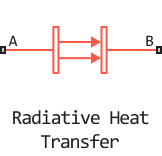Radiative Heat Transfer
Heat transfer by radiation.
blockType: AcausalFoundation.Thermal.Elements.Radiation
|
Path in the library: |
Description
The Radiative Heat Transfer unit represents the transfer of heat by radiation between two bodies. The process is described by the Stefan-Boltzmann law:
Where:
-
- heat flux.
-
- radiation coefficient.
-
- surface area.
-
and are the temperatures of the two bodies.
The radiation coefficient is determined by the geometric shapes, dimensions and radiation coefficient of the surface. For example, the radiation constant for heat transfer between two parallel plates is calculated as:
Where:
-
- Stefan-Boltzmann constant.
-
- is the radiation coefficient of the radiating plate surface.
-
- radiation coefficient of the receiving plate surface.
Similarly, the radiation coefficient for concentric cylinders is determined by the formula
where and are the radii of the radiating and receiving cylinders, respectively.
A and B are thermal ports corresponding to different bodies. Since the positive direction of the block is from port A to port B, the heat flux is positive if it flows from A to B.
Ports
A is body A
`body
Heat port corresponding to body A.
B - body B
heat
Heat port corresponding to body B.
Parameters
Area - heat exchange area
1e-4 m² (by default) | positive scalar
Heat exchange area.
Radiation coefficient - radiation heat transfer coefficient
4e-8 W/m²/K^4 (by default) | positive scalar
Radiation heat transfer coefficient between two bodies based on their geometric shape, size and surface emissivity.
Initial value of temperature difference - initial value of temperature difference
0.0 K (by default).
Initial value of temperature difference.
Initial value of heat flow rate - initial value of heat flow rate
0.0 W/(K*m²) (by default).
Initial value of heat flow rate.
